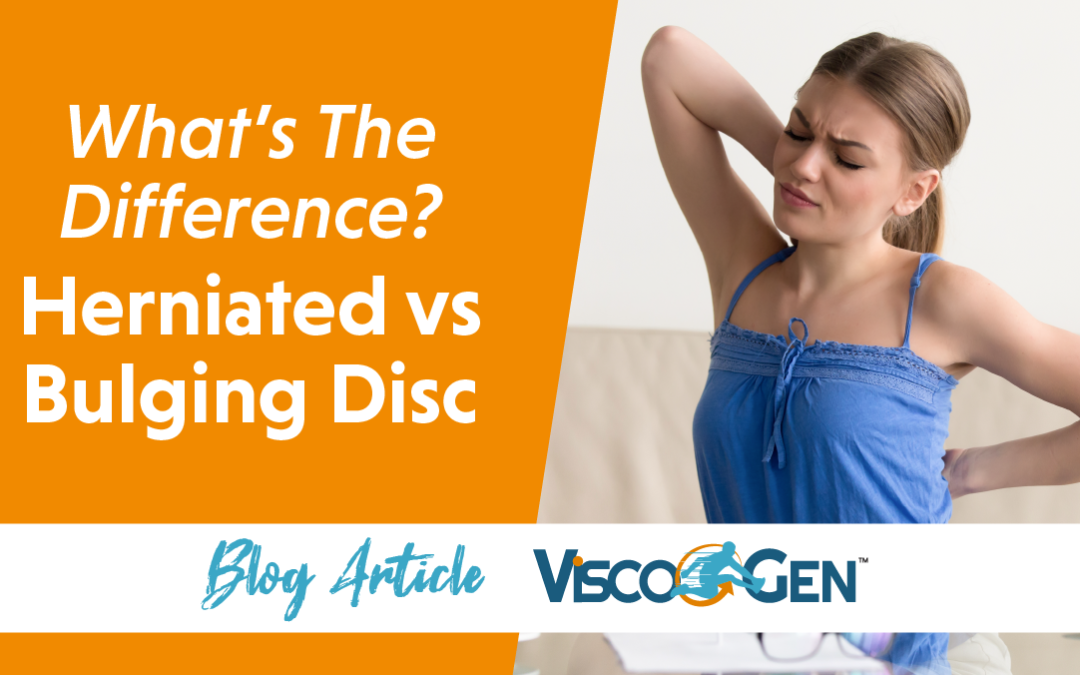The terms “bulging disc” and “herniated disc” sound like they describe the same thing, but there’s a difference. While both terms relate to vertebrae – bones that protect your spine – and refer to different levels of bone spurs, the difference has to do with the degree and how it affects nerves and other areas within your spine.
If you’re experiencing back problems, it’s important to know what the differences are between these two conditions, so you can get the right treatment—and find some relief.
To better understand bulging vs herniated discs, you first need to know a bit about the spine intervertebral discs.
Understanding Spine Intervertebral Discs
Our bodies need discs to provide structure and support. The disc itself is a jelly-like cushion that sits between the bones of your spine (vertebrae) and provides stability to your back. Surrounding your discs are strong, “cushion” like pads called the ligaments.
Your spine’s vertebrae are covered by a tough, fibrous sack called the dura. The spinal cord travels throughout the length of your spine protected by this tough sac. There is also a protective layer of fluid that surrounds your spinal cord as well as providing nutrition for nerve cells as they travel to all parts of your body.
You need a strong disc to handle daily pressure from activities such as bending, lifting, and twisting. When there is too much pressure on the center of the disc, it can push against the outer edge, causing an annular tear (a small tear in the outer circle of the disc). This can lead to a bulging or protruding disc if too much pressure is put on the disc.
What is the Key Difference between a Bulging and Herniated Disc?
A bulging disc is when the interior jelly-like substance of the disc bulges out from between two vertebrae and pushes on nearby nerves. A herniated disc on the other hand, is when a disc ruptures, or tears, and spills its contents.
Both conditions can be painful and can be the result of an accident. The difference is that a bulging disc can happen anywhere along your spine, while a herniated disc usually occurs where the disc is weakest.
In most cases, a herniated disc produces more pain, and can lead to more serious problems. A bulging disc, on the other hand, generally heals itself without causing long-term problems.
There is no standard diagnostic test for herniation, so doctors use several tools to diagnose a herniated disc. These include X-rays, MRI scans and a physical exam.
What are the Causes and Symptoms of Bulging and Herniated Discs?
Bulging or herniated discs usually have similar causes, a common one being degeneration of the discs due to aging. Others may include spinal injury, bad posture, genetics, among others.
Common symptoms of bulging vs herniated discs include:
- Numbness or tingling
- Muscle spasms
- Pain/ burning sensation on the back and limbs
- Muscle weakness
Get Professional Non-Surgical Treatments Orlando
Patients have been turning to surgery to try and solve their pain problem. But these surgeries come with a myriad of risks from anesthesia, from infections from lack of blood flow, among others. This is where ViscoGen ™ comes in, providing an alternative to surgery for back pain.
We are a premier non-surgical orthopedic care facility specializing in the treatment of musculoskeletal injuries and disorders. We offer two treatment options for knee and back pain: Knee Pain Program & the Advanced Spine Decompression. Both treatments are non-invasive and get rid of your pain by eliminating the pressure on the nerve endings where they join the spinal cord.
With our advanced proprietary technology, we can improve or restore your function and get you back to where you love to be. Contact us today for more information.




